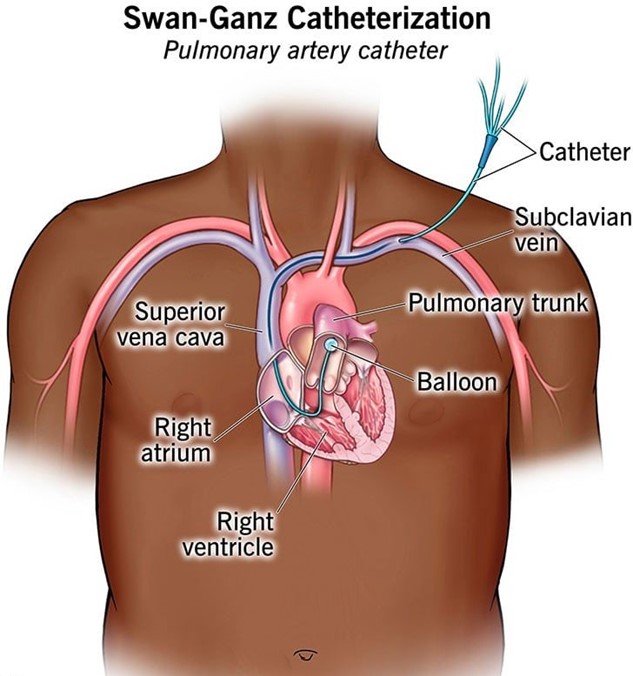A nurse in an emergency room is caring for a client who sustained partial-thickness burns to both lower legs, chest, face, and both forearms. Which of the following is the priority action the nurse should take?
Administer intravenous pain medication.
Draw blood for a complete blood cell (CBC) count.
Insert an indwelling urinary catheter.
Inspect the mouth for signs of inhalation injuries.
The Correct Answer is D
Choice A Reason: This choice is incorrect because administering intravenous pain medication is not the priority action for a client who has sustained partial-thickness burns. Pain medication may be indicated for pain relief and comfort, but it does not address the potential life-threatening complications of burns such as shock, infection, or respiratory distress.
Choice B Reason: This choice is incorrect because drawing blood for a CBC count is not the priority action for a client who has sustained partial-thickness burns. A CBC count may be useful to monitor the hematological status and detect any signs of infection or anemia, but it does not address the immediate needs of the client
Choice C Reason: This choice is incorrect because inserting an indwelling urinary catheter is not the priority action for a client who has sustained partial-thickness burns. A urinary catheter may be necessary to measure the urine output and assess the renal function and fluid balance, but it does not address the most urgent problem of the client.
Choice D Reason: This choice is correct because inspecting the mouth for signs of inhalation injuries is the priority action for a client who has sustained partial-thickness burns. Inhalation injuries are caused by inhaling hot air, smoke, or toxic gases that damage the airway and lungs. They can cause airway obstruction, bronchospasm, pulmonary edema, or respiratory failure. Therefore, the nurse should inspect the mouth for signs such as soot, singed nasal hairs, burns on the lips or tongue, hoarseness, stridor, or wheezes. The nurse should also monitor the oxygen saturation and arterial blood gases to assess the oxygenation and ventilation status of the client.
Nursing Test Bank
Naxlex Comprehensive Predictor Exams
Related Questions
Correct Answer is C
Explanation
Choice A Reason: Albumin 25% is not a medication that the nurse should plan to administer for a client who is experiencing Cushing's triad following a subdural hematoma. Albumin 25% is a colloid solution that increases the oncotic pressure and draws fluid from the interstitial space into the intravascular space, which can worsen the intracranial pressure by increasing the cerebral blood flow and edema.
Choice B Reason: Dextran 70 is not a medication that the nurse should plan to administer for a client who is experiencing Cushing's triad following a subdural hematoma. Dextran 70 is a plasma expander that increases the blood volume and viscosity, which can also worsen the intracranial pressure by increasing the cerebral blood flow and edema.
Choice C Reason: Mannitol 25% is a medication that the nurse should plan to administer for a client who is experiencing Cushing's triad following a subdural hematoma. Mannitol 25% is an osmotic diuretic that reduces the intracranial pressure by creating an osmotic gradient and drawing fluid from the brain tissue into the blood vessels, which can then be excreted by the kidneys. The nurse should monitor the urine output, serum osmolality, and electrolytes when administering mannitol 25%.
Choice D Reason: Hydroxyethyl starch is not a medication that the nurse should plan to administer for a client who is experiencing Cushing's triad following a subdural hematoma. Hydroxyethyl starch is another plasma expander that has similar effects as dextran 70, and can also increase the risk of coagulopathy and renal failure.
Correct Answer is A
Explanation
Choice A Reason: This is correct because a pulmonary artery catheter is a device that measures the pressures and flows in the heart and lungs, such as the pulmonary artery pressure, the pulmonary artery wedge pressure, the cardiac output, and the mixed venous oxygen saturation. These parameters reflect the hemodynamic status of the client, which is the balance between the cardiac output and the systemic vascular resistance.
Choice B Reason: This is incorrect because a pulmonary artery catheter does not measure spinal cord perfusion, which is the blood flow to the spinal cord. Spinal cord perfusion can be affected by spinal cord injury, spinal anesthesia, or spinal surgery.
Choice C Reason: This is incorrect because a pulmonary artery catheter does not measure renal function, which is the ability of the kidneys to filter waste products and maintain fluid and electrolyte balance. Renal function can be assessed by urine output, blood urea nitrogen, creatinine, and glomerular filtration rate.
Choice D Reason: This is incorrect because a pulmonary artery catheter does not measure intracranial pressure, which is the pressure inside the skull. Intracranial pressure can be increased by brain injury, stroke, tumor, infection, or hydrocephalus.

Whether you are a student looking to ace your exams or a practicing nurse seeking to enhance your expertise , our nursing education contents will empower you with the confidence and competence to make a difference in the lives of patients and become a respected leader in the healthcare field.
Visit Naxlex, invest in your future and unlock endless possibilities with our unparalleled nursing education contents today
Report Wrong Answer on the Current Question
Do you disagree with the answer? If yes, what is your expected answer? Explain.
Kindly be descriptive with the issue you are facing.
